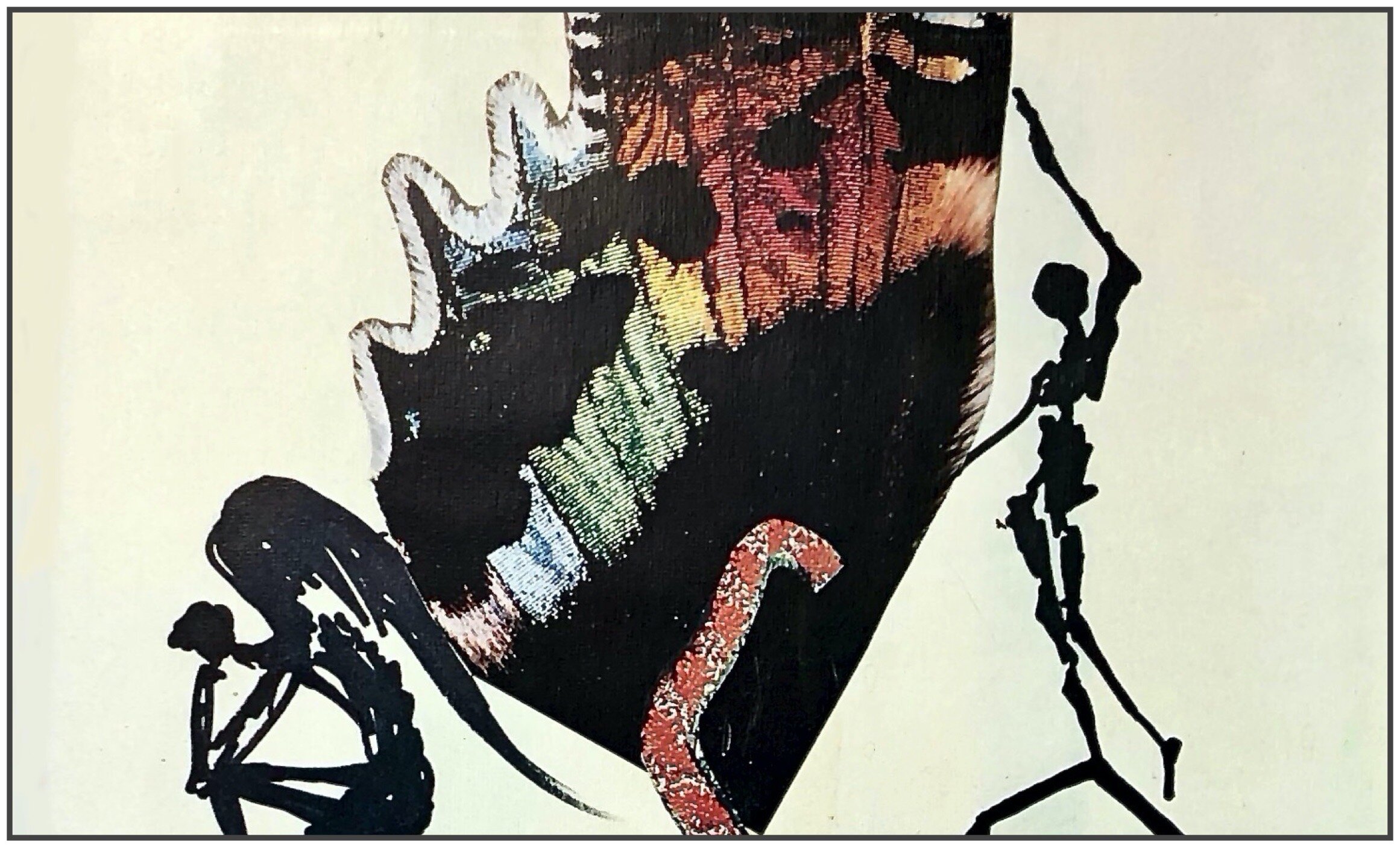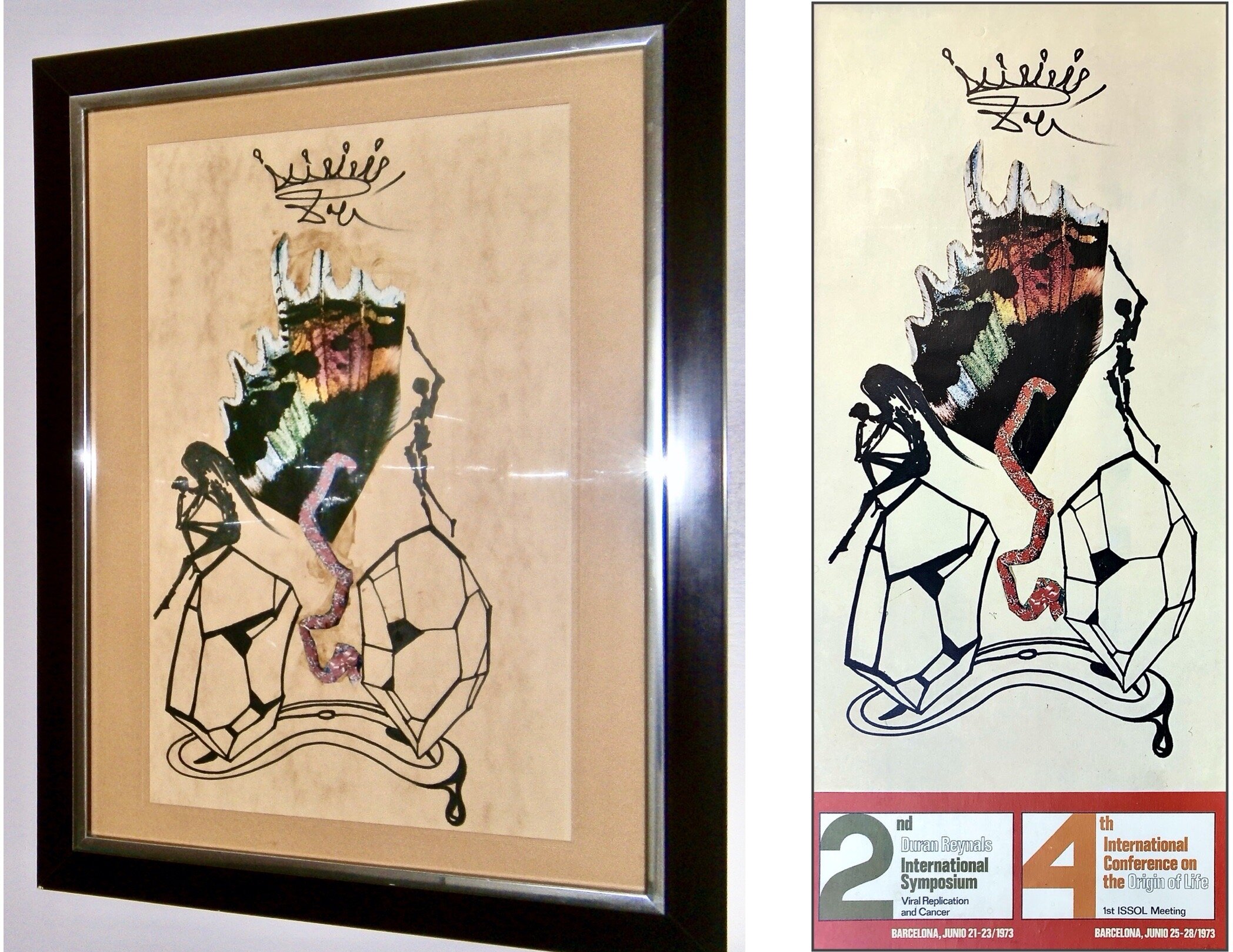I am not aware of when my father, Joan Oró, came to know Salvador Dalí. Both prominent Catalans, they likely knew of each other's work. Possibly, they met in the late '60s or early '70s. Nevertheless, at some point, Oró asked Dalí if he would create artwork for two scientific meetings planned for June 1973 in Barcelona, Spain. Dalí agreed.
The resulting mixed media piece is stunning in its execution and insight. Containing only eight elements, it succinctly encapsulates the origin of life on Earth, the only known life in the universe.
Professor Joan F. Oró
To understand the artwork, a bit of background on the life of Joan (John) Oró. (Catalan pronunciation of Joan.) Born in 1923 in Lleida, Spain, Oró obtained his degree in chemistry, with a focus on organic chemistry, at the University of Barcelona in 1947. He married Francesca the following year and over the next five years, the couple had three children: Maria Elena, Joan (this author), and Jaume.
Together with colleagues, Oró established a series of small chemical manufacturing businesses that produced soap, chemicals for the pharmaceutical industry, and antiseptics. Each business was challenging. Not wanting to request more funding from the family, his childhood dream of studying the origin of life began to re-awaken. Given the confined nature of science in Spain during that era, Oró knew he would have to move. He submitted over 50 applications to universities throughout the US. Of the six schools accepting him tuition-free, Joan selected Rice Institute in Houston and moved to the US in 1952.
Partway through his first year at Rice, Oró met prominent Baylor College of Medicine scientist Donald Rappaport and was recruited into Baylor's Ph.D. program. There, he immersed himself in biochemical research that would become fundamental to his later discoveries in life's origin.
Following his training at Baylor, Oró joined the University of Houston as a professor of biochemistry in September 1955. In January 1958, he was able to bring his family to the US, where the couple's fourth child, David, was born.
Origin of Life Research
In 1959, Oró was working to extend the experiments by Stanley Miller in Harold Urey's lab at the University of Chicago. Miller and Urey’s studies had revealed that organic matter, specifically amino acids, could arise from a non-organic pre-biotic soup. This demonstrated that inorganic matter, in the right conditions, could turn into organic matter, the matter of life. Influenced by his understanding of cometary composition, Oró had added additional compounds to the mix. As described in ABC CIENCIA:
On Christmas Day 1959, Oró performed an experiment in his laboratory that would be crucial to the study of the origin of life. With the intention of reproducing the conditions that existed on Earth 4 billion years ago, Oró exposed to heat and ultraviolet light a solution that contained hydrogen cyanide and other chemical compounds that are usually present in comets. The chemical reaction he induced in his laboratory produced amino acids, the basic "bricks" of proteins, as predicted by current theories.
The surprise was that in that chemical reaction was also synthesized adenine, one of the four chemical bases that make up DNA (deoxyribonucleic acid), the molecule of life.
Since the production of adenine, a nucleic acid within our DNA, was beyond what Oró considered possible, he thought it must have been a contaminant. Upon rigorously repeating the experiment, there it was again! A bright spot on the chromatograph at the precise position of adenine. It would be one of the happiest moments of his life.
Original mixed-media creation on the left. Now aged with time. Poster for the two 1973 meetings held in Barcelona, Spain on the right.
“The Origin of Life”
While the academic environment in the US nourished his scientific work, Oró was also dedicated to advancing science in the country of his birth. Thus, 14 years following his seminal 1959 experiment, he was organizing an origin of life conference in Barcelona, the stimulus for Dali’s mix-media creation.
If Dalí’s artwork had a name, I never heard it. For me, it can only be “The Origin of Life.” At its base, Dalí incorporated a soft melting watch present in various forms in a number of his paintings. In the view of Dawn Adès of the Department of Art History and Theory at the University of Essex:
The soft watches are an unconscious symbol of the relativity of space and time, a Surrealist meditation on the collapse of our notions of a fixed cosmic order.
In my father’s explanation, the soft watch - also referred to as a melting clock - located at the base or the artwork represents the beginning of time and the origins occurring within it.
Enantiomers & DNA
Above the melting clock are two crystals representing optical isomers, also known as enantiomers. Like a right and left hand, enantiomers are non-superimposable mirror images of each other. This handedness of biological molecules is known as chirality.
(To better understand chirality, imagine a spiral staircase. Most often, they are left-handed, turning to the left as one descends downward. “According to one theory, the staircases are left-handed to allow right-handed people to hold onto the railing and walk on the outer, wider part of the steps when coming down the stairs.” Left-handed spiral staircases are similar to right-handed spiral staircases but are not the same. They are mirror images of each other, thus are not superimposable. Humans preferentially choose to create left-handed spiral staircases. But why are DNA and RNA almost exclusively right-handed instead of a mix of right and left-handed versions? The most recent theory: cosmic rays.)
Returning to the question of life, Suzanna Kohler writes:
Living organisms are homochiral, being built almost exclusively from left-handed amino acids and right-handed sugars and nucleotides which preferentially construct right-handed DNA and RNA.
Would life “work” if DNA and RNA were instead formed in their mirror images – that is - left-handed? In Wonderland, Lewis Carroll’s Alice wondered as much. As described by Professor Anna Proykova:
Chirality held Alice's attention as she pondered the macroscopic world she glimpsed through the looking glass, and her musings over whether looking-glass milk would be good to drink presaged our quest to understand the molecular importance of chirality.
The next component of Dalí’s piece is a coral red wreath. On Dalí’s original creation (above, left), the wreath appears to be a photograph Dalí cut and coiled to suggest a helix. This simple, yet powerful element represents DNA, the self-replicating core of almost all known life.
Via DNA and natural selection, life exploded into the beautiful array present in our world. Dalí’s representation of this unimaginable blossoming by using a butterfly wing is genius.
The Dali Crown
At the apex of the piece is the artist's signature seen flowing into a crown. The crown’s origin: a photograph of a drop of milk.
Fascinated by both illusion and science, the artist was captivated by a famous 1946 stroboscopic photo of a drop of milk by American engineer Harold Edgerton, in which the splash appears to take the shape of a coronet. He based his image on that famous close-up. Both a Catholic and a supporter of monarchy, Dalí saw a variety of literary, religious, and theatrical connotations in the shape.
Jacob’s Ladder
Of the eight elements in Dalí’s artistic creation, Jacob's ladder is the most intriguing. The ladder is represented here by an angel seen standing on each isomers. In the Book of Genesis, a ladder leading to heaven appeared to Jacob in a dream:
Jacob went out from Beer-sheba, and went toward Haran. And he lighted upon the place, and tarried there all night, because the sun was set; and he took one of the stones of the place, and put it under his head, and lay down in that place to sleep. And he dreamed, and behold a ladder set up on the earth, and the top of it reached to heaven; and behold the angels of God ascending and descending on it.
Inclusion of the two angels – one reflective and the other caressing - represents the role of divine providence in the creation and blossoming of life.
At center, in a white shirt and bowtie, is origin-of-life theorist Alexander Oparin. To his right is Joan Oró. To his left is to Salvador Dalí. Dr. Oró's wife Frances Oró is to the right of Joan Oró. Photo: Figueres, Catalunya.
Simplicity & Beauty
The relationship between Joan Oró and Salvador Dalí resulted in a fusion of art and science. Dalí’s creation graced posters for the 4th International Conference on the Origin of Life and the program proceedings. Their successful partnership led to other scientific and medical artistic creations. In an interview while in his seventies, Joan Oró summarized his impression of Dali’s contributions:
The simplicity and beauty of the works show a deep understanding ‘expressed in a way no scientist could.’
Dali’s The Origin of Life piece is the property of the Fundació Joan Oró.



